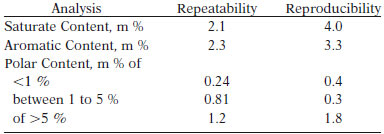EXPLANATION
This test method is used for classifying oil samples of initial boiling point of at least 200° C into the hydrocarbon types of polar compounds, aromatics, and saturates, and recovery of representative fractions of these types. This classification is used for specification purposes in rubber extendor and processing oils since the composition of the oil included in rubber compounds has a large effect on the characteristics and uses of the compounds. This test method is not directly applicable to oils of greater than 0.1 m % pentane insolubles. Such oils can be analyzed after removal of these materials, but precision is degraded.
TEST SUMMARY
The sample is diluted with solvent and charged to a glass percolation column containing clay at the top and silica gel plus clay in the bottom. The column is charged with n-pentane, and then the upper clay section is removed and washed further with n-pentane. Next it is charged with 50:50 toluene-acetone mixture for desorption. The gel column is desorbed with toluene. The solvents are completely removed from the recovered solvent fractions; the residues are weighed and calculated as saturates polar compound contents. Aromatics are calculated by difference, or measured after evaporation of the toluene fraction used for the desorption of the gel column.
TEST PRECISION

This test method has no known bias.



